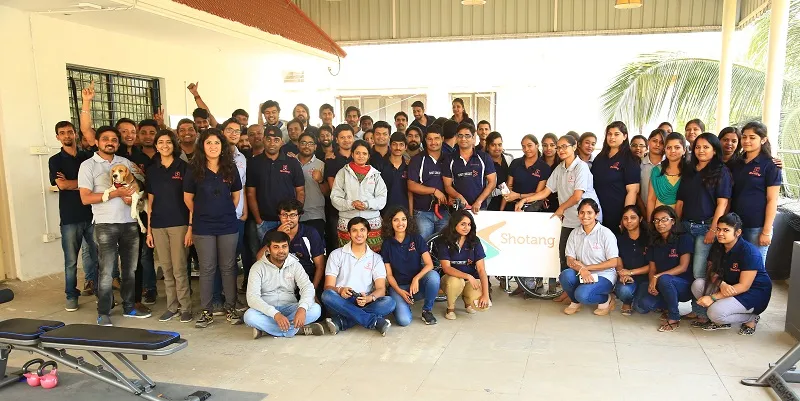How Sabonka Technologies' Shotang is helping retailers manage their working capital
Technology can bring efficiency to the way the country’s three lakh mom-and-pop handset retailers do business.
In the sweat-filled streets of Thippasandra Market in Indiranagar, Bengaluru, Ganpaty, a cellphone retailer, is busy talking to customers in broken Kannada. Hailing from Rajasthan, Ganpaty has been doing business in the city over the past five years and knows too well the importance of speaking the local language. When he is not attending to customers in his 400-sqft store, he uses an app to order his inventory.
“This app allows me to choose phones that are priced competitively by wholesalers and I can get the phones that move in the market. Around 60 percent of my order value comes from this app,” says Ganpaty, founder of Vasavi Cell Park. He adds that the app helps him keep a tight leash on his working capital since he invests only in fast-moving inventory.
“Earlier, I had to buy what was sold by the distributor of a particular brand and go by his idea of the market,” he says. Now he is able to decide and place the order for a stock that he wants and gets the delivery the same day.
His monthly turnover from this “high-volume, low-margin business” is Rs 40 lakh on which Ganpaty makes a net of 3-4 percent.

A similar scene is being played out at a warehouse in the old weaver market of Chamrajpet, one of the many traditional business hubs of Bengaluru. Umang Bhatoria of Mahapadmavathi Wholesales, who stocks more than 60 brands of mobile phones, mentions that over a year ago, his business was limited to only the southern and western parts of Bengaluru with sales to around 100 retailers.
Now he uses an app to manage his sales for the whole city and reaches over 1,800 retailers. “I have more power, now, to speak to mobile phone distributors and tell them what sells and what does not sell. They can improve their channel strategies thanks to the immediate information available from my smartphone,” says Umang.
His monthly sales are around Rs 1.5 crore and he makes around 2 percent net of the total sales. Both Umang and Ganpaty have increased their turnover by about 50 percent over the last year or so. Umang drops the prices while maintaining his margin optimally, and is able to move his inventory faster to guys like Ganpaty and transfer the margin benefit to him too.
What is driving this?
The app that people like Ganpaty and Umang are talking about has been built by Sabonka Technologies, whose platform — Shotang — is enabling the supply chain for retailers, wholesalers, and OEMs. Founded in 2013 as a channel strategy advisory website called Channelyst, Shotang in its present form was established in November 2015.
The company claims its GMV rate for the financial year 2016-2017 to be Rs 440 crore. Although it did not deliver any revenues in the financial year 2015-16, with losses pegged at Rs 2.3 crore, this is not a true reflection of the company’s ability to build a business. Its real potential can be tracked by the end of the financial year 2018–19 because it is solving a very intricate problem in the country — it is using consumer data from the retailers to change the way handset manufacturers build their channel strategy locally.
Currently, handset manufacturers, like other consumer goods companies, deploy stock in bulk into the market without knowing what sells in each suburb. This system makes wholesalers and retailers lock in their working capital for stocking items that do not move fast. Technology can solve this problem and make it transparent for handset manufacturers, wholesalers and distributors.
Coming back to Shotang, the platform's largest cost will be the number of delivery boys that it employs and it has to invest in a strong technology team that can make sense of the data which throws up buying patterns from every locality. This data can be useful for handset manufacturers as they will not need to depend on the master distributors in a region for intelligence. Distributors are a cost centre because they push handset sales based on their inventory rather than what is selling in the market.
However, the opportunity is huge because there are over three lakh mobile phone retailers in the country who have not used technology. Shotang enables them to stock what really sells and gets the inventory delivered the day the order is placed. In the traditional system, orders are delivered on a weekly or fortnightly basis and the retailer does not have the choice of stocking items based on his preferences.
Over the last year, Shotang has expanded to five Indian cities (Delhi, Pune, Bengaluru, Hyderabad, and Chennai) and aggregated over 10,000 retailers and 85 suppliers or wholesalers. The company raised $5 million from Exfinity Ventures and Unitus Impact in 2015. It had raised $300,000 in an angel round earlier.
“The mobile phone channel strategy is very fragmented and the industry has not used technology to understand retailers, who know the market better than anyone else,” says Anish Basu Roy, CEO of Shotang. He adds that the monthly active user rate, by retailers, is about 65 percent. A retailer orders more than four times a month on the Shotang app, with an average order value of nearly Rs 18,000.
According to Shotang, today 30 percent of a retailer’s inventory needs are satisfied through the platform. Says Anish,
“The inflection point for the company will happen when we get retailers to order 60 percent of their stock from our platform. This allows us to go negotiate better prices with brands.”
Why is this significant? Every brand in India knows there is no way they can ignore the mom & pop stores if they have to penetrate Indian consumption. In India, e-commerce covers less than 40 million people and the rest are served through an intricate supply chain where cash is king and there is no transparency in data. There are a total of 15 million retailers in India, depending on which report one picks the data from, but it would be safe to say there are around 10 million mom & pop stores in the country. According to Ernst and Young, the retail industry is a $600-billion market, of which only 10 percent is organised.
“Since all three of us have a decade's experience of working with traditional retailers while we were at Nokia and other corporate entities, we knew the problems of distribution inefficiencies that would hurt the brand, and we went after solving them,” says Anterpreet Singh, co-founder of Shotang.
The business model
The company charges the supplier a transaction fee on every order. The payments to the supplier are settled on a T+5 basis through direct bank transfers. The company also provides credit to retailers with the help of lending platforms like Capital Float.
There are businesses similar to Shotang which work with small retailers. Mobisy Technologies with its brands, and Distiman and Bizom, are trying to change grocery/FMCG business distribution. Mobisy works with close to 3,000 retail stores in two cities. Then there are businesses like Snapbizz, Stockwise, Super Zop, and XLogix, all of which are trying to solve how small retailers/wholesalers can streamline their supply chain based on consumption patterns using technology, therefore making the OEMs or manufacturers change their channel strategy. “The end beneficiary is the retailer and the consumer,” says Vishal BG, Director, Operations and co-founder at Shotang.
Snapbizz has raised close to $10 million and sources say Mobisy Technologies has raised over $1 million in debt capital.
“Shotang's product is unique and can disrupt the way traditional distribution chain operates, enabling the small store owner to be at par with large organised retail,” says Jayaroopa Jeyabarathi, Principal at Unitus Impact. She adds that the team has expertise in distribution and understands the needs of the retailers well.
Shailesh Ghorpade, Managing Partner at Exfinity Ventures says,
“In India, there is a disproportionate value extraction by distributors who have archaic, inefficient processes — totally manual — and their only value add is to connect to last-mile retail.”
According to him, these inefficient processes do not provide brands with any visibility beyond distributors who are already reeling under the onslaught of online commerce. “Shotang solves the problem and makes offline retailing efficient,” adds Shailesh.

The founders of Shotang owe it to their 300-member team and also the tech that makes distribution intelligent. While the founders put in long hours, they are making their team understand the importance of being fit and energetic. The three are also avid bikers and travel across the country, journeys that bring them in contact with different folks from the kirana ecosystem. These lessons led to the birth of Shotang, the platform and the brand name.
The word "Shotang" was coined by the team to denote an expression of being annoyed at a person's carelessness. Maybe the word fits like a glove because they are solving the inefficiencies and the carelessness of the old supply chain systems. The registered name of the company is Sabonka Technologies.







